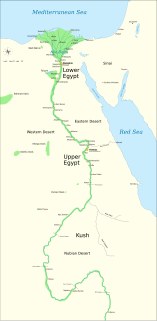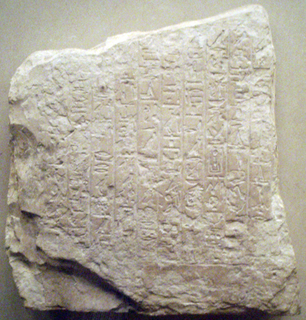
Pharaoh is the common title now used for the monarchs of ancient Egypt from the First Dynasty until the annexation of Egypt by the Roman Empire in 30 BCE, although the term "pharaoh" was not used contemporaneously for a ruler until Merneptah, c. 1210 BCE, during the Nineteenth dynasty, "king" being the term used most frequently until the middle of the Eighteenth Dynasty. In the early dynasties, ancient Egyptian kings used to have up to three titles: the Horus, the Sedge and Bee (nswt-bjtj), and the Two Ladies or Nebty (nbtj) name. The Golden Horus as well as the nomen and prenomen titles were added later.

Merneferre Ay was an ancient Egyptian pharaoh of the mid 13th Dynasty. The longest reigning pharaoh of the 13th Dynasty, he ruled a likely fragmented Egypt for over 23 years in the early to mid 17th century BC. A pyramidion bearing his name shows that he possibly completed a pyramid, probably located in the necropolis of Memphis.

Ptah is an ancient Egyptian deity, the god of craftsmen and architects. In the triad of Memphis, he is the husband of Sekhmet and the father of Nefertem. He was also regarded as the father of the sage Imhotep.

An epistle is a writing directed or sent to a person or group of people, usually an elegant and formal didactic letter. The epistle genre of letter-writing was common in ancient Egypt as part of the scribal-school writing curriculum. The letters in the New Testament from Apostles to Christians are usually referred to as epistles. Those traditionally attributed to Paul are known as Pauline epistles and the others as catholic epistles.

The ankh or key of life is an ancient Egyptian hieroglyphic symbol that was most commonly used in writing and in Egyptian art to represent the word for "life" and, by extension, as a symbol of life itself.

The First Intermediate Period, described as a 'dark period' in ancient Egyptian history, spanned approximately one hundred and twenty-five years, from c. 2181–2055 BC, after the end of the Old Kingdom. It comprises the Seventh, Eighth, Ninth, Tenth, and part of the Eleventh Dynasties. The concept of a "First Intermediate Period" was coined in 1926 by Egyptologists Georg Steindorff and Henri Frankfort.

The Middle Kingdom of Egypt is the period in the history of ancient Egypt following a period of political division known as the First Intermediate Period. The Middle Kingdom lasted from approximately 2050 to 1710 BC, stretching from the reunification of Egypt under the reign of Mentuhotep II in the Eleventh Dynasty to the end of the Twelfth Dynasty. The kings of the Eleventh Dynasty ruled from Thebes and the kings of the Twelfth Dynasty ruled from el-Lisht.

The Ipuwer Papyrus is an ancient Egyptian hieratic papyrus made during the Nineteenth Dynasty of Egypt, and now held in the Dutch National Museum of Antiquities in Leiden, Netherlands. It contains the Admonitions of Ipuwer, an incomplete literary work whose original composition is dated no earlier than the late Twelfth Dynasty of Egypt.
Ptahhotep, sometimes known as Ptahhotep I or Ptahhotpe, was an ancient Egyptian vizier during the late 25th century BC and early 24th century BC Fifth Dynasty of Egypt.

Smenkhkare Imyremeshaw was an Egyptian pharaoh of the mid 13th Dynasty during the Second Intermediate Period. Imyremeshaw reigned from Memphis, starting in 1759 BC or 1711 BC. The length of his reign is not known for certain; he may have reigned for five years and certainly less than ten years. Imyremeshaw is attested by two colossal statues now in the Egyptian Museum, Cairo.

The Stele of Ankh-ef-en-Khonsu is a painted, wooden offering stele located in Cairo, Egypt. It was discovered in 1858 by François Auguste Ferdinand Mariette at the mortuary temple of the 18th Dynasty Pharaoh Hatshepsut, located at Dayr al-Bahri. It was originally made for the Montu-priest Ankh-ef-en-Khonsu i, and was discovered near his coffin ensemble of two sarcophagi and two anthropomorphic inner coffins. It dates to circa 680–70 BCE, the period of the late 25th Dynasty/early 26th Dynasty. Originally located in the former Bulaq Museum under inventory number 666, the stele was moved around 1902 to the newly opened Egyptian Museum of Cairo, where it remains today.

The offering formula, also known under transliterated forms of its incipit as the ḥtp-ḏỉ-nsw or ḥtp-ḏj-nswt formula was a conventional dedicatory formula found on ancient Egyptian funerary objects, believed to allow the deceased to partake in offerings presented to the major deities in the name of the king, or in offerings presented directly to the deceased by family members. It is among the most common of all Middle Egyptian texts.
A valediction, or complementary close in American English, is an expression used to say farewell, especially a word or phrase used to end a letter or message, or the act of saying parting words whether brief or extensive.

Battiscombe George "Jack" Gunn, was an English Egyptologist and philologist. He published his first translation from Egyptian in 1906. He translated inscriptions for many important excavations and sites, including Fayum, Saqqara, Amarna, Giza and Luxor. He was curator at the Egyptian Museum in Cairo and at the University Museum at the University of Pennsylvania in Philadelphia. In 1934 he was appointed Professor of Egyptology at the University of Oxford, a chair he held until his death in 1950.

In the 1350 BC correspondence of 382–letters, called the Amarna letters, the prostration formula is usually the opening subservient remarks to the addressee, the Egyptian pharaoh. The formula is based on prostration, namely reverence and submissiveness. Often the letters are from vassal rulers or vassal city-states, especially in Canaan but also in other localities.

Karduniaš, also transcribed Karduniash, Karaduniyaš, Karaduniše, Kurduniash) is a Kassite term used for the kingdom centered on Babylonia and founded by the Kassite dynasty. It is used in the 1350-1335 BC Amarna letters correspondence, and is also used frequently in Middle-Assyrian and Neo-Assyrian texts to refer to the kingdom of Babylon. The name Karaduniyaš is mainly used in the letters written between Kadashman-Enlil I, or Burna-Buriash, the Kings of Babylon, and the Pharaoh of Ancient Egypt-(called: Mizri), letters EA 1-EA 11, a subcorpus of letters,. Much later, a version of the name was used in the Babylonian Talmud as Kardunya referring to similar locations. In the Assyrian texts its referred to as Kardu.

Ancient Egyptian literature was written in the Egyptian language from ancient Egypt's pharaonic period until the end of Roman domination. It represents the oldest corpus of Egyptian literature. Along with Sumerian literature, it is considered the world's earliest literature.

Wahkare Khety was an ancient Egyptian pharaoh of the 9th or 10th Dynasty during the First Intermediate Period.

Meryhathor or Meryt-Hathor, was a pharaoh of the 10th Dynasty of Egypt, during the First Intermediate Period.

The Coptos Decrees are 18 complete or fragmentary ancient Egyptian royal decrees ranging from the 6th Dynasty to the late 8th Dynasty. The decrees are numbered with letters of the Latin alphabet, starting with "Coptos Decree a" and ending with "Coptos Decree r". The earliest of the series were issued by Pepi I and Pepi II Neferkare to favor the clergy of the temple of Min, while the others are datable to the reign of various kings of the 8th Dynasty, and concern various favors granted to an important official from Coptos named Shemay and to his family members. The decrees reflect the waning of the power of the pharaoh in the early First Intermediate Period.

















